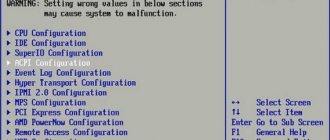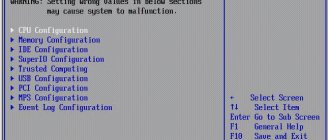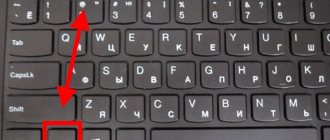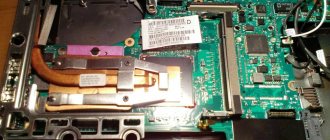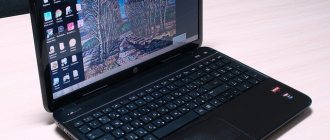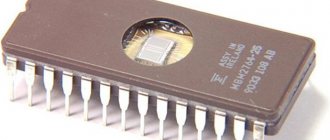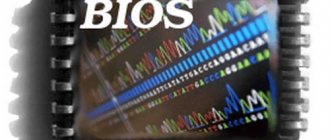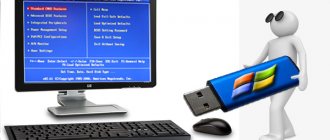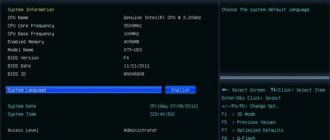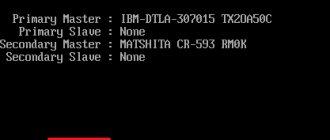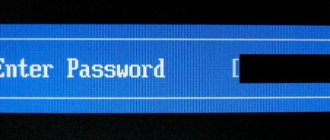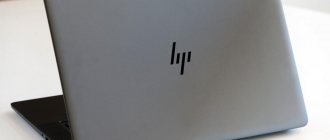There are probably no PC users who do not need to go into the BIOS at least once during the entire time they work with the computer. Those who use Samsung products did not stand aside either.
This manufacturer has a huge list of laptops, and not all of them can enter the BIOS in the same way, but setting it up is easy - the functions are the same everywhere. Today we will try to figure out how to enter the BIOS on a Samsung laptop.
Why might there be a need to enter the BIOS on Samsung? Even though laptop manufacturers in each new released model try to minimize the user’s PC knowledge requirements and give the simplest possible answer to the question of how to configure it or determine the cause of problems, sometimes there is a need for finer adjustment of parameters. What can you use this input for:
- Turning on and off some laptop hardware, diagnosing problems;
- Configuring boot parameters for the OS and the entire device;
- Configuring the disk subsystem, in particular, its operating modes;
- Customization of many other functions, parts or the system in general.
Ways to enter BIOS on a Samsung laptop
I am glad to welcome you, my dear readers. In my series of articles about ways to enter the BIOS, I left the most seasoned manufacturers of modern technology for dessert. And today I will talk about how to enter the BIOS on a Samsung laptop.
Despite the big name and leadership in the markets of other devices, Samsung laptops are no longer among the top three in terms of sales in Russia. But they consistently make it into the Top 5. This means that among you, friends, there will be many users who will be especially interested in this article.
Let me remind you that the basic system settings are hardwired into one of the chips on the motherboard, and work with them is carried out using a simple program called BIOS. In it you can set the date and time, work with passwords, change the order of work with boot devices, disable the touchpad, adjust the frequency of the processor and RAM chips, and set power parameters.
Of course, the most common use of BIOS is booting from a flash drive to install Windows. In the same way, you can restore the system while saving important data.
Let's go to BIOS
As you can see, knowing how to enter the BIOS, you can solve many complex problems. So let's get down to business quickly, but first make sure that your laptop won't accidentally turn off while working with system settings. This is highly undesirable as it can practically destroy your device ;).
But let's not talk about gloom, just recharge the battery or connect the power supply (to be on the safe side, use both energy sources).
Now turn on or reboot your desktop computer and immediately start pressing the “magic” “F2” key a couple of times per second. In most cases, you will see the BIOS in front of you.
Each BIOS has its own approach
But this option may not work. The fact is that although Samsung has not conquered the entire laptop market, it has presented a large number of different models (NP, R, RC and others), which, in addition to the electronic filling, also differ in the way they enter the BIOS.
- For example, for the RV 513 line, in addition to F2, it is worth trying Delete;
- The ATIV Book series, which is small in number, also has its own exception to the general rule. ATIV Book 4 450R5E-X07 owners should remember the “F8” button.
- In the most common NP 300 series, the F2 key is also the main one. But in the NP 300V5AH model you should press F10;
- In the more advanced model NP900X3E, you need to press two “Fn+F12” keys at once.
As you can see, there can be a variety of ways. And this is largely due to the hardware of your laptop.
Therefore, in addition to F2, you should always have in stock such “BIOS” keys as F8, F12, Delete, or the popular key combinations “Fn+F2”, “Ctrl+F2” or “Fn+F8”. But it’s better to still pay attention to the inscriptions that appear on the monitor during the loading process. Especially these ones: “Press (key) to run setup.”
This is what you and I are looking for.
Actually, this is all you need to know to load BIOS smoothly on a Samsung laptop. I think you can easily master these simple skills. And you will be able to handle your PC at a professional level.
With that, I wish everyone good luck and say: “See you soon on my blog!”
How to enter Bios on a Samsung laptop
How to enter BIOS on a Samsung laptop
All operations performed in the BIOS system are quite serious, so if you have insufficient experience in this system, it is better not to experiment, as this can have very dire consequences.
You should contact Samsung laptop specialists.
However, if you are determined to achieve a specific goal, we will tell you how to enter the basic input/output system (this is what BIOS is literally called) on a Samsung laptop.
How to enter BIOS in a Samsung laptop and how to update it
The new generation of UEFI that replaced BIOS has made it more difficult to penetrate the holy of holies on laptops. Gone are the days when every user could easily get there by rebooting the computer and pressing the Delete button. Or, if this did not help, press some other keys from the functional group - F6, F8 or others.
This article will talk about how to enter the BIOS . It looks like you are already desperate, asking yourself the question - is this even possible on your laptop? Maybe you don’t have any BIOS?
Do not be afraid! Now you can easily and simply complete the necessary steps. We will do this using the example of a SAMSUNG NP350V5C laptop with Windows 8 installed on it.
We will also look at how you can update the BIOS, and at the end of the article there is a video on how to configure it before installing Windows 7 or 8.
Let's divide the BIOS startup process into 2 stages. So, let's go...
Stage 1: how to enter the boot menu
There are two radically different methods.
The first is with the help of a specially performed reboot of the laptop. This is the recommended method. The second one is useful as a last resort if you cannot log into the system to make the settings of the first method.
Option with proper reboot
Just drag your mouse vertically along the right edge of the screen until a pop-up menu appears. You can also call it using the keyboard by pressing Win + C.
Next, click “ Settings ”, then “ Change computer settings ”. Then click “ Update and Recovery ”.
The manufacturer has pushed this option too far!
Now click “ Recovery ” and here it is - the treasured item “ Special boot options ” - click on “ Restart now ”.
Your Samsung (or whatever you have) will dutifully reboot and end up in the boot menu.
Extreme method
I used this method once when my laptop experienced a serious crash after updating one of the applications. The laptop froze at startup and did not want to display the authorization window. Consequently, I could not log into the system to do a reboot with special parameters.
I needed to do this to restore the system, but if you have the same problem, it will help you enter the BIOS.
I warn you! This method can only be used as a last resort, when there are no other options left.
This is done like this (I performed these steps on a Samsung product):
- You connect your laptop to the network
- Start the system.
- If you disconnect (remove) the battery, the laptop continues to work.
- Disconnect the laptop from the network.
- You wait for a short time.
- Connect the battery.
- Plug it into the network.
- Start by pressing the power button.
- After these steps, you will find yourself in the system boot menu.
Stage 2: Launch BIOS
If you did everything correctly, then you will see the system boot menu, in which you should click on the “ Diagnostics ” item.
Next, click on “ Advanced options ”.
And then - to “ UEFI Firmware Settings ”
We move on to the final phase of the launch - click “ Restart ”.
The screen will go dark and after a short (or maybe long) time you will see the BIOS screen:
BIOS update
It is strongly recommended to update the BIOS only from the official websites of manufacturers.
In my case, in the browser you need to go to the Samsung website and enter the full model name (written on the bottom of the laptop case): NP350V5C-S1JRU
After pressing the Enter button, a list appears in which we select an item from the category “ Built-in software ”
Next, scroll down the screen and find “ Update Software ”, click on it, which leads to downloading the file BIOSUpdate.exe
Since I downloaded it from the official Samsung website, I can safely run it
and update the BIOS of the laptop:
In my case, the latest update is already installed. If you have a new version available, you just have to click the last button to update the BIOS.
on the topic of setting up BIOS for installing Windows 7 or 8
Source: https://UstanovkaOS.ru/poleznye-sovety/kak-zajti-v-bios-v-samsung.html
Stage 2: Launch BIOS
If you did everything correctly, then you will see the system boot menu, in which you should click on the “ Diagnostics ” item.
Next, click on “ Advanced options ”.
And then - to “ UEFI Firmware Settings ”
We move on to the final phase of the launch - click “ Restart ”.
The screen will go dark and after a short (or maybe long) time you will see the BIOS screen:
How to enter BIOS on a Samsung laptop? How to enter BIOS on a Samsung laptop
I am glad to welcome you, my dear readers. In my series of articles about ways to enter the BIOS, I left the most seasoned manufacturers of modern technology for dessert. And today I will talk about how to enter the BIOS on a Samsung laptop.
Despite the big name and leadership in the markets of other devices, Samsung laptops are no longer among the top three in terms of sales in Russia. But they consistently make it into the Top 5.
This means that among you, friends, there will be many users who will be especially interested in this article.
Let me remind you that the basic system settings are hardwired into one of the chips on the motherboard, and work with them is carried out using a simple program called BIOS. In it you can set the date and time, work with passwords, change the order of work with boot devices, disable the touchpad, adjust the frequency of the processor and RAM chips, and set power parameters.
Of course, the most common use of BIOS is booting from a flash drive to install Windows. In the same way, you can restore the system while saving important data.
How to enter BIOS on Samsung
To get into this mode, when you turn on your laptop or desktop computer, you must immediately hold down the “F2” key for 5-10 seconds. This is a generally accepted method, but in some Samsung laptop models the startup process is different. For example:
- In models of the RV 513 line, the Delete button is pressed together with F2;
- If you have a 450R5E-X07 ATIV Book series model, only the “F8” key is required.
- The NP 300V5AH laptop requires the F10 button;
- To open the Bios in the NP900X3E laptop, you need the “Fn+F12” key combination.
BIOS - what is it and why is it needed?
The abbreviation stands for “Basic Input Output System” or “Basic Input-Output System”. It starts when you turn on the device and is a black screen on which white letters and numbers are displayed. When the PC starts, it tests the subsystems, after which it transfers control to the OS bootloader and the operating system itself.
It is worth saying that modern models of laptops from hp, lenovo, asus, acer, samsung, and sony vaio are equipped not with BIOS, but with its more advanced version - UEFI. There is no difference between the data systems in terms of access. The only thing is that UEFI is a more modern version of the software, which simply replaces the outdated BIOS, performing its functions.
How to set up Bios
The touchpad or mouse will not work in this mode. You can move between elements using the arrow keys. The “Enter” key will help you select the desired option, Esc to return to the previous menu.
In the settings system you will find and configure the following parameters:
Time and date. In modern devices, these parameters are configured automatically; it is impossible to configure them manually without experience. BIOS provides this opportunity. To debug, go to the section of the same name and use the arrows on the keyboard to change the time and date numbers. Save your changes.
How to connect a Samsung printer to a laptop
Selecting the speed of the hard disk controller. This line is called CMOS Setup Utility: “Storage Configuration” or “Advanced”. Here you can debug SATA controllers by adjusting the processor loading speed and the features of the source that is a priority when loading.
The type of media from which the system boots first. This is an important parameter that affects the process of reinstalling the system and each time it boots when turned on. By default, the fastest drive is specified, such as an SSD. With the correct settings, this parameter speeds up or slows down the operating system by 2-3 times.
The parameter is called “Hard Disk Boot Priority”. Once you enter it, you will see existing disks, you can delete unnecessary ones or create new ones. A disk is also installed here, from which the system will boot at each startup.
The same parameter selects the boot element when installing Windows. Windows does not always come to us on a licensed CD, so if you received a USB flash drive or DVD, select them after connecting to the laptop.
The “System Voltage Control” parameter will help enable the ability to regulate voltage on the main modules.
We have listed only the most frequently used parameters by ordinary users. In reality, of course, there are much more of them. You can find out the meaning of each at a Samsung service center, as well as using a manual for setting up certain functions on your laptop.
Source: https://brit03.ru/ustrojstva/kak-otkryt-bios-na-noutbuke-samsung.html
How to configure BIOS to boot OS from another media
As a rule, setting up the Bios menu on a computer device is most often necessary to correctly install the operating system from a specific medium - a flash drive or disk. Although recently, a USB drive is increasingly being used as an installation distribution for installing Windows versions seven or eight. So, in order for your device to start booting from another device, we will definitely need to make some adjustments in the Bios system. It should be noted that it is not at all difficult to carry out this mission, and if desired, every owner of a Samsung laptop can do this, regardless of his level of computer awareness.
Bios setting:
- The first thing we need to do is insert the flash drive into a USB slot or disk, depending on what media you want to boot the OS from.
- After this, we need to enter the Bios menu on the Samsung laptop. This is done in a very simple way (as on most models) - turn on our device and immediately press the F2 key. When you log into the Bios successfully, a window will open in front of us, which contains all the general data about the system. What do we do next?
- Next, we go to the “Security” security menu, in it we find the “Secure Boot Control” section and set the “Disabled” mode and confirm our action by pressing Enter.
- Then in the “OS Mode Selection” section that opens, enter the value “UEFI and Legacy OS”.
- Next we find the section that concerns the choice of loading the OS - “Boot” and click on it. In this tab we need to select the “Boot Device Priority” subcategory, which is located at the very head of the list. At this point, select the device from which the operating system will be loaded.
- You can exit the Bios menu by simply pressing the ESC key.
- To save all changes made to the settings, go to the “Exit” item and confirm the choice of action with the enter key.
Using the BIOS menu, you can configure many other parameters, for example, change the processor temperature, increase or decrease the amount of device memory, and much more. As a rule, the default values are the most optimal values necessary for the correct operation of your laptop, so you should approach any changes to them carefully. Good luck!
Top 8 ways to enter BIOS on a computer and laptop | blog comfy
BIOS is a kind of software repository that affects the operation of the hardware of a laptop computer.
Therefore, often when some failures occur that are not related to the software, or when connecting new components to the device, it is necessary to test or configure the laptop, and for this you need to log into the BIOS. In order to get into the system, you need to press a certain combination on the keyboard before booting the laptop.
Subscribe to our Telegram channel
What is Bios
BIOS is a basic information input and output system that relates to system software. It is a set of firmware designed to control the hardware of a laptop, or more precisely:
- To check the functionality of the laptop hardware.
- Control laptop hardware through commands.
- Participates in loading the operating system.
- Provides an API for working with equipment.
- Setting the hard drive priority (boot).
- For overclocking the GPU, CPU, and RAM.
- Setting the system time.
- Disabling or enabling some equipment, for example, RAM, video card, if several are installed, and you need to understand the reason for the error that occurs.
- By going into Bios on your laptop, you can adjust the battery performance.
- Calibrate the operation of the touch part of the laptop.
- View all technical data on the configuration.
In simple terms, what is BIOS - this is software that implements the normal operation of a laptop based on the installed hardware; its main feature is the initial check and launch of the OS.
In this case, the input and output system is stored on a separate BIOS microchip of the same name, which is located next to the motherboard. Depending on the motherboard manufacturer, the microchip can be either removable or soldered to the board.
Control, after entering the Bios , is carried out using the keys: DEL, F1, F2, ESC. F9 key – resets all settings to factory settings if you have gone too far with the parameters. The F10 button works as automatic saving of the entered data.
The input and output system, like other software, may require updating, especially if you have updated your laptop components.
How to enter Bios on Lenovo
On a Lenovo laptop, entering Bios largely depends on the device model. Most often, you can log in using the F2 key before the laptop computer is fully loaded; if you don’t have time, try again.
There are Lenovo models in which you can enter the BIOS by simultaneously pressing the Fn+F2 buttons. It is very rare that you can enter Lenovo Bios by simultaneously pressing other buttons - F8+ DEL.
If you still cannot log in, try removing the battery. Another way is to not just hold down the button, but quickly press it (suitable if the BIOS is called via F2).
In advanced Lenovo models there is a separate side button for calling up Bios.
How to enter Bios on Asus
On Asus laptops, logging into the Bios system is done in the classic way via F2 by pressing it or quickly pressing it.
If the input was not made, then it occurs when you can call the input and output system using the combination DEL + F9 or pressing these buttons in turn.
Users often complain that they still cannot enter the Bios, then they need to turn off the laptop completely and press the ESC button. When pressed, the BOOT menu appears, in it select the Enter Setup tab, which is activated by pressing Enter. You have all entered the Asus Bios.
How to enter Bios on Acer
Don't know how to enter Bios on an Acer laptop? The developers themselves probably don’t know this. For some reason they encrypted the method in such a way that even users do not have a clear answer. It can be seen that the entrance to Bios on Acer largely depends on the laptop model.
They work like the classic method of logging in via F2, using the methods described above, and you can also start the system using F1. For portable device models, there is also an input using a combination of three buttons - Ctrl+Alt+Esc. In older devices, long combinations may also occur - Ctrl+Alt+Del.
In the Acer Aspire series, you can most often call up the Bios by pressing Ctrl+F2 at the same time. On Acer TravelMate and Extensa, login is accomplished by pressing F2/Del.
How to enter Bios on HP
To enter the HP Bios you will have to suffer; there are a lot of variations for calling the system. At the same time, there are tricky ways when you need to go through a whole complex of processes. The traditional option does not work on this laptop; the most common way to enter HP Bios is to hold down the ESC or F10 key.
If this method does not work, then try pressing the same buttons, but quickly, rather than holding them down. Did not work out? Then here is another list of buttons that can call up the system menu on different models - F6, F8, F11, Del, ESC.
How to enter Bios on Samsung
You can enter Bios on a Samsung laptop using the familiar F2, F8, F12 or Del buttons. But there are call combinations that are different from other laptop brands. In this case, the input must be made through Fn - Fn+F2, Fn+F8, Fn+F12. The buttons must be pressed simultaneously.
How to enter Bios Sony Vaio
In Sony Vaio models, you can enter the BIOS through a special button - ASSIST.
It is pressed when turning on the laptop or rebooting before the software has completely loaded. After you click on the button, a small menu will appear where you can select the Start BIOS Setup subcategory. Now you can start working in Bios. In older models, the call occurs through the standard F2 button, as well as pressing F1, F3, Delete.
How to enter Bios on Windows 10
Don't know how to enter Bios on Windows 10? You can do this in two ways:
- Via the keyboard. Reboot or turn on the laptop and before the device boots up, press the F2 key 2 times per second. The difficulty of turning it on is that even with intense pressure, you may not have time to boot the system. Then you'll have to try again.
- The second method is based on simultaneously pressing the Shift key and clicking “Restart” through the Start menu.
How to enter Bios on Windows 7
Similar to other operating systems, to enter Bios on Windows 7 you must press a certain key or a combination of keys while the computer is booting.
Depending on the motherboard manufacturer, there may be the following combinations:
- AMD BIOS→F1.
- Phoenix Award BIOS→Ctrl+Alt+Esc, Ctrl+Alt+Ins, Ctrl+Alt+S.
- DTK BIOS→ Esc.
- Award BIOS→ Del, Ctrl+Alt+Esc.
- ALR BIOS→ F2, Ctrl+Alt+Esc.
- AMI BIOS→ F2, Del.
Single commands most often do not need to be held down, but rather must be pressed at a speed of 2 clicks per second.
, please select a piece of text and press Ctrl+Enter.
Source: https://blog.comfy.ua/kak-zapustit-bios-na-noutbuke-ili-pk_a0-9/
Keys to start
Let's look at the basic key combinations that are often used to get into it:
- "F2" is the most common key to enter the BIOS. It is intended for laptops from Lenovo, Acer, Asus, Panasonic, Fujitsu-Siemens, Sony, Samsung, Dell, and Toshiba.
- "ESC" is used, like "F2", in some Toshiba models.
- “F10” is intended for HP and Dell laptops.
- "F1" is sometimes used in Lenovo devices.
Continuation of the list of keys for some models
:
Now you know how to enable the BIOS yourself. You just need to remember a few important rules that will definitely help you with this:
“BIOS” is the basic system of any computer device.
Its task comes down to testing the equipment before loading the operating system. Even though your laptop is a Samsung laptop, the button to enter Bios may not be the same (F2, F12, F8, Del, Esc). This is due to what brand of motherboard is used for this device. To enter the basic structure system, you will need to connect your laptop to a power source. A power failure when working with the “BIOS” can have a bad effect on the computer system. When restarting the laptop, press the “pause” key or the “Fn+pause” combination. The inscription on the monitor should open: “press F2 (f8, f12, f4, etc.) to enter setup.” Whichever combination (f2, f12, f4, f8...) appears in this line, we will click on that one to enter the “BIOS”. To return to “WINDOWS”, press “Enter”. If you haven’t found any information here, then go to the Internet and collect data about your maternal system. When you do not know the brand of this board, then right-click on the “Start” menu, left-click on “Properties”, a window should appear, in it select “Hardware”. Then open “Device Manager” and find the motherboard in the “Computer Configuration” sub-items. We remember its name and enter a query into Google, adding “to enter setup/Bios”. There it will be described which button to use to enter “bios”. On some devices, information about the board is located on a sticker with the name of the laptop or near the battery connector. After searching for the desired symbol, reboot the laptop and press this symbol before the pictures appear on the screen. While in the “BIOS”, we use only the keyboard. When selecting an item, click on the arrows (↓) or right, left. To confirm the selected actions, we usually press “Plus” (+) or (-) “Minus”.
Samsung laptop how to enter BIOS
I am glad to welcome you, my dear readers. In my series of articles about ways to enter the BIOS, I left the most seasoned manufacturers of modern technology for dessert. And today I will talk about how to enter the BIOS on a Samsung laptop.
Despite the big name and leadership in the markets of other devices, Samsung laptops are no longer among the top three in terms of sales in Russia. But they consistently make it into the Top 5. This means that among you, friends, there will be many users who will be especially interested in this article.
Let me remind you that the basic system settings are hardwired into one of the chips on the motherboard, and work with them is carried out using a simple program called BIOS. In it you can set the date and time, work with passwords, change the order of work with boot devices, disable the touchpad, adjust the frequency of the processor and RAM chips, and set power parameters.
Of course, the most common use of BIOS is booting from a flash drive to install Windows. In the same way, you can restore the system while saving important data.
Can’t enter BIOS on a laptop – [solved] • CompBlog.ru – computer blog
Greetings to all readers of the computer blog compblog.ru! The other day I came across a Samsung NP300E5C-S0VRU laptop with the BOOTMGR is Missing problem. The problem is basically standard. The solution is to restore the bootloader via Live-CD, or reinstall Windows. Since, according to the client, the hard drive was formatted, they decided to reinstall it.
No problem - everything is as usual, go to the BIOS, set to boot from a flash drive, install Windows. Let's go... Oops... Not so fast, bro!
Samsung NP300E5C laptop does not enter BIOS when pressing f2
The laptop interrupted the process of its revival at the first point. When I pressed F2, it wrote “Entering SETUP” for a split second, but still continued booting from the hard drive, and persistently displayed the message BootMgr is Missing.
Physically disconnecting the hard drive did not give any results - the laptop simply went into a cyclic reboot, preventing either entering the BIOS via F2 or launching Recovery Mode via F4.
Poking around on the Internet showed that the problem is quite common, specifically for this model. The fact is that this laptop has the keyboard locked by default when entering the BIOS. When reinstalling Windows from 8 to 7, you first had to go into UEFI via Win8, disable Secure Boot, and enable CSV. And then carry out some actions to reinstall Windows.
The owner of the laptop somehow formatted the hard drive without first changing the BIOS settings, and, accordingly, got a “vicious circle” - in order to enter the BIOS, you had to install the OS, and in order to install the OS, you had to go into the BIOS.
BIOS won't start on laptop
There are different solutions to this problem offered on the Internet, but I will offer mine, which I have personally tested.
List of what you will need:
- Hard drive with Windows already installed . Where can I get it? As I did (the easiest way), remove the hard drive from another laptop. As a repairman, I have a lot of laptops, and this has not been a problem. I borrowed a HDD with Windows 7 installed. You can borrow a hard drive with Windows 7 or 8 installed from a friend.
- Remove your hard drive from the problem laptop, insert it into another laptop (although you can also into a desktop computer, the interface for connecting SATA hard drives is universal), install Windows on it (without drivers), insert it back into your laptop. In principle, this already solves the problem with installing Windows, but does not solve the problem with the BIOS and subsequent system reinstallations.
How to update BIOS on a laptop?
So, you have a hard drive with the OS installed, you inserted it into your laptop. We launch it, the OS should load. We install pre-downloaded drivers on the network adapters, connect the laptop to the Internet via Wi-Fi or cable.
We launch the BIOS update program downloaded from the off. site. This is what the Bios update utility window looks like on Samsung laptops (in the background is the Samsung website, where everything was downloaded from):
As you can see in the picture, the current system BIOS version is the same as the latest bios version available for download (firmware P09RAP). This is because I took the photo after the update.
These versions most likely do not match for you, so, firstly, make sure that you have a battery inserted and charged at least 30%, and a network device is connected. Secondly, click the “Update” button.
Next, we don’t touch the computer, it will do everything it needs and go into reboot. We are waiting for the BIOS to update.
So, the progress of the BIOS update has reached its end, the laptop has rebooted. Most likely, the OS will now stop loading, but now this is not a problem for us, because the BIOS is unlocked! We press F2 when loading, change the settings to the ones we need (disable Secure biot and enable Legacy CSV), and calmly install any Windows we want!
Laptop does not enter BIOS - [solved]
It is possible that the problem where bios does not start when you press F2 can also occur on other laptops besides Samsung. It can also occur when replacing a hard drive . Everything can be solved by updating the bios to the latest version. And updating the BIOS is not such a complicated procedure, as you can see by reading this article!
The most important thing is that there is no sudden power outage, otherwise we will get a “brick”. Which will have to be revived by disassembling the laptop, desoldering the BIOS chip with a hot air gun, flashing it through the programmer, and soldering it back. This is an operation that is no longer available to everyone. I will talk about this in one of the following articles on compblog.ru.
Source: https://CompBlog.ru/ne-zahodit-v-bios-na-noutbuke.html
How to enter BIOS on a laptop
Nowadays, laptop manufacturers are doing everything possible to ensure that their owners can fix the problem as easily and quickly as possible, without leaving the operating system. But it’s worth clarifying that laptops are designed on the same principles as desktop PCs, and in some cases it’s impossible to cope without getting into the BIOS settings.
For example, if you decide to reinstall the OS or an error occurs while overclocking a component. How can you enter the BIOS on a laptop in this case? This is quite simple to do, but let's talk about everything in order.
BIOS - what is it and why is it needed?
The abbreviation stands for “Basic Input Output System” or “Basic Input-Output System”. It starts when you turn on the device and is a black screen on which white letters and numbers are displayed. When the PC starts, it tests the subsystems, after which it transfers control to the OS bootloader and the operating system itself.
It is worth saying that modern models of laptops from hp, lenovo, asus, acer, samsung, and sony vaio are equipped not with BIOS, but with its more advanced version - UEFI. There is no difference between the data systems in terms of access. The only thing is that UEFI is a more modern version of the software, which simply replaces the outdated BIOS, performing its functions.
Is it worth getting into the settings?
If you are an inexperienced user, then you should stay away from it and not interfere unnecessarily.
This can be explained by the fact that changing parameters without understanding your actions can damage the computer and it will simply stop booting.
If you don’t understand what a particular function does, just don’t touch it, otherwise your actions may end badly not only for the laptop, but also for your wallet.
Couldn't solve the problem? Contact a specialist for help!
Solve my problem
If you are at least a little knowledgeable about PCs and have an idea of what a BIOS is and how to work with it, then, if necessary, you can open the BIOS on your laptop yourself and do what you need. We will talk further about how to do this.
Login to BIOS
In order to enter the BIOS on a laptop, regardless of the type of Windows Xp, 7, 8 or 10 installed, hot keys or combinations thereof are used.
And they depend not only on the laptop manufacturer, but also on the motherboard.
That is why you should remember the key combination intended specifically for your PC, because at the most inopportune moment you may not have either instructions or another device with Internet access at hand.
Another difficulty that you may encounter when you need to call up the BIOS is how to boot your laptop quickly. While you are reading the inscriptions and deciding which button you still need to press, the OS will begin to load.
To avoid getting into this situation, you need to either know the hotkeys that activate the bios on your device, or use the function of pausing the system boot (called by pressing the Pause key).
However, not all laptops support this option.
Operating system "BIOS"
The abbreviation "BIOS" stands for "Basic Input/Output System". This is a microcircuit with memory installed on the motherboard of the device. In order for the microcircuit to function, a battery must be present. The BIOS contains information that makes it possible to test and boot the computer.
If the laptop or computer works normally, boots and reboots, then there is no need to log into the system. However, if there are any problems, the reason may be precisely the failure of the BIOS. It is also needed to reinstall the operating system. The main task of the BIOS is to have a boot menu (Boot Priority).
